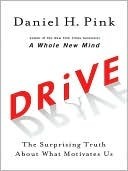More on this book
Community
Kindle Notes & Highlights
Read between
December 3 - December 17, 2022
“that enjoyment-based intrinsic motivation, namely how creative a person feels when working on the project, is the strongest and most pervasive driver.”
intrinsic motivation—the drive to do something because it is interesting, challenging, and absorbing—is essential for high levels of creativity.
Ford is so intent on producing a certain car at a certain weight at a certain price by a certain date that it omits safety checks and unleashes the dangerous Ford Pinto.
The problem with making an extrinsic reward the only destination that matters is that some people will choose the quickest route there, even if it means taking the low road.
When the reward is the activity itself—deepening learning, delighting customers, doing one’s best—there are no shortcuts.
an “if-then” reward to help develop mastery usually backfires. That’s why schoolchildren who are paid to solve problems typically choose easier problems and therefore learn less.
If, at age fourteen or forty-three, we’re passive and inert, that’s not because it’s our nature. It’s because something flipped our default setting.
others have shown that people high in intrinsic motivation are better coworkers.
encouraging autonomy doesn’t mean discouraging accountability.
Control leads to compliance; autonomy leads to engagement.
Only engagement can produce mastery.
The improvement was the goal. The medal was simply the ultimate reward for achieving that goal.”
“The desire to do something because you find it deeply satisfying and personally challenging inspires the highest levels of creativity,
One source of frustration in the workplace is the frequent mismatch between what people must do and what people can do. When what they must do exceeds their capabilities, the result is anxiety. When what they must do falls short of their capabilities, the result is boredom.
To analogize to physical qualities, incremental theorists consider intelligence as something like strength. (Want to get stronger and more muscular? Start pumping iron.) Entity theorists view it as something more like height.
In one view, intelligence is something you demonstrate; in the other, it’s something you develop.
Dweck says they come in two varieties—performance goals and learning goals. Getting an A in French class is a performance goal. Being able to speak French is a learning goal.
As wonderful as flow is, the path to mastery—becoming ever better at something you care about—is not lined with daisies and spanned by a rainbow. If it were, more of us would make the trip. Mastery hurts.
“Being a professional,” Julius Erving once said, “is doing the things you love to do, on the days you don’t feel like doing them.”
This is the nature of mastery: Mastery is an asymptote. You can approach it. You can home in on it. You can get really, really, really close to it. But like Cézanne, you can never touch it.
The mastery asymptote is a source of frustration. Why reach for something you can never fully attain? But it’s also a source of allure. Why not reach for it? The joy is in the pursuit more than the realization.
As you contemplate your purpose, begin with the big question: What’s your sentence?
Staying motivated—directing your own life, making progress, and pursuing purpose—isn’t easy.
“Deliberate practice is about changing your performance, setting new goals and straining yourself to reach a bit higher each time.”
Prepare for the process to be mentally and physically exhausting. That’s why so few people commit to it, but that’s why it works.
The better strategy is to get compensation right—and then get it out of sight.
We’re bribing students into compliance instead of challenging them into engagement.
Good grades become a reward for compliance—but don’t have much to do with learning.
Meanwhile, students whose grades don’t measure up often see themselves as failures and give up trying to learn.
children who are praised for “being smart” often believe that every encounter is a test of whether they really are. So to avoid looking dumb, they resist new challenges and choose the easiest path.
all human beings are naturally curious and that the best kind of learning happens when it’s initiated and pursued by the one doing the learning,
Interpret challenges not as roadblocks, but as opportunities to stretch yourself.
“Do rewards motivate people? Absolutely. They motivate people to get rewards.”
we see the toll that mastery can take—and the thrill it can produce when it’s realized.
Type I behavior concerns itself less with the external rewards an activity brings and more with the inherent satisfaction of the activity itself.
Smart workplaces therefore supplement day-to-day activities with “Goldilocks tasks”—not too hard and not too easy.
mastery also abides by three peculiar rules. Mastery is a mindset: It requires the capacity to see your abilities not as finite, but as infinitely improvable. Mastery is a pain: It demands effort, grit, and deliberate practice. And mastery is an asymptote: It’s impossible to fully realize, which makes it simultaneously frustrating and alluring.
Rewards can turn play into work. The positive: Focusing on mastery can turn work into play.


